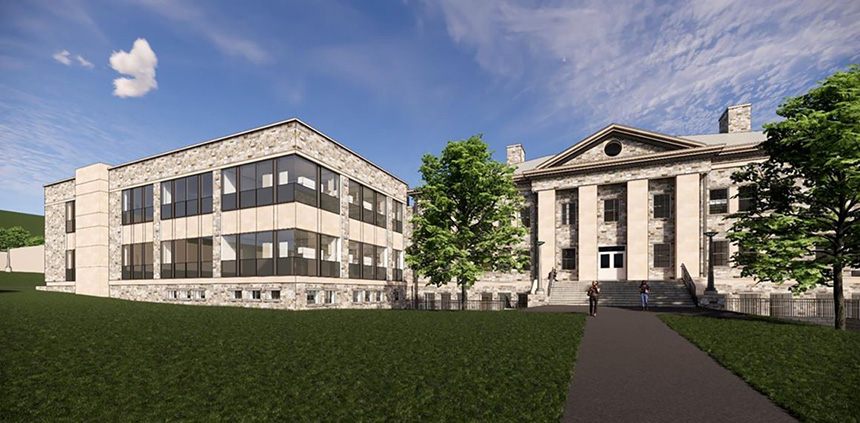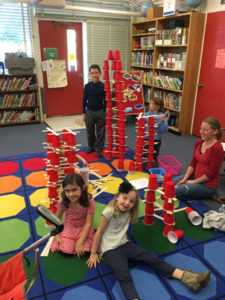Richard D. L. Fulton
Photo Courtesy of MSMU

Proposed addition (left) to the university’s Coad Science Building.
Mount Saint Mary’s University (MSMU) will be receiving $4 million in federal workforce development STEM funds to help meet the region’s increased demand for growth in science, technology, engineering, and mathematics.
STEM is an acronym for science, technology, engineering, and mathematics.
According to Donna Klinger, MSMU executive director of communications, the funds will be used to help complete the 21,000 square-foot addition and renovation of the university’s Coad Science Building, noting that, “The Mount has experienced significant growth in science and technology programs and the funds will be used to create state-of-the-art labs and teaching spaces to meet the demands of future learners.”
Klinger reported that the scope of work for the Coad Science Building includes three phases that will begin in March, with the addition of neuroscience, computational, and microscopy research labs, as well as collaborative learning spaces. The second phase will contain the second and third levels of the addition with science labs, classrooms, and experiential research spaces. The third phase will renovate the existing space in the Coad Science Building, according to the communications executive director.
The appropriation, she said, was secured by U.S. senators Ben Cardin and Chris Van Hollen and Representative David Trone, “who support the expansion of the Coad Science Building and work-based training in rural Maryland,” adding, “The members of Congress expressed support for the Mount’s efforts to build educator-industry partnerships and strengthen cross-disciplinary STEM courses, especially in computer science, cybersecurity and the physical sciences.”
The federal funds stem from federal congressionally directed spending from the Fiscal Year 2023 Omnibus Appropriations Bill, signed into law on December 29, 2022. Congressionally directed spending allows members of Congress to recommend important projects in their state or district for consideration by the Senate and house appropriations committees.
MSMU President Timothy Trainor stated, “We are grateful to Congressman Trone and senators Cardin and Van Hollen for their support of the university’s expansion and renovation of our STEM research facilities to support American competitiveness in high-demand fields such as computer science, data science, cybersecurity, neuroscience and biological, environmental, and physical sciences, as well as contribute to a highly trained STEM workforce for the state of Maryland.”
Senator Cardin stated, “Maryland’s future economy is a STEM economy, and our workforce must be trained and equipped to thrive in these fields. This new, $4 million investment in Mount Saint Mary’s Coad Science Building will ensure that its students who are seeking expertise in the STEM fields have a first-class learning facility to prepare them.”
Senator Van Hollen, a member of the Appropriations Committee, emphasized that STEM skills are more in demand than ever, and teaching students in these fields will help prepare them for well-paying jobs while strengthening Maryland’s workforce, adding, “That’s why we fought to deliver this direct federal funding for Mount St. Mary’s.”
“Providing every Marylander an opportunity to succeed, especially in high-skill, sought-after trades like STEM, is a win-win for all of us. Not only will these programs help develop our country’s future leaders, but they will also create and fill jobs down the line in our state,” Congressman Trone stated.
Built in 1964, Coad is a three-story 50,100 square-foot building serving the School of Natural Science and Mathematics, which has outgrown the existing space and needs to be renovated for modern STEM pedagogical practices. The new classroom and lab spaces will be technology-rich, multi-use, flexible, and configurable for a variety of instructional formats and class sizes.
The $20 million Coad expansion and renovation project is also being funded by a $2 million grant from the State of Maryland, in conjunction with donations made in support of the project through the “Forward! Together as One Campaign.” A lead donation from George B. Delaplaine, Jr. will provide the collaborative space, to be called the Delaplaine Family Academic Commons.
Other top-level donors contributing to the expansion project are the Page Family Foundation; Trish and D.J. Monagle; Paula and Fred Neuer; and Christina Lee and Mark Sobus, J.D.


